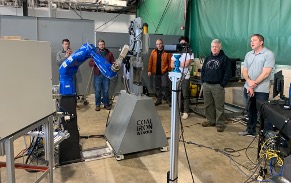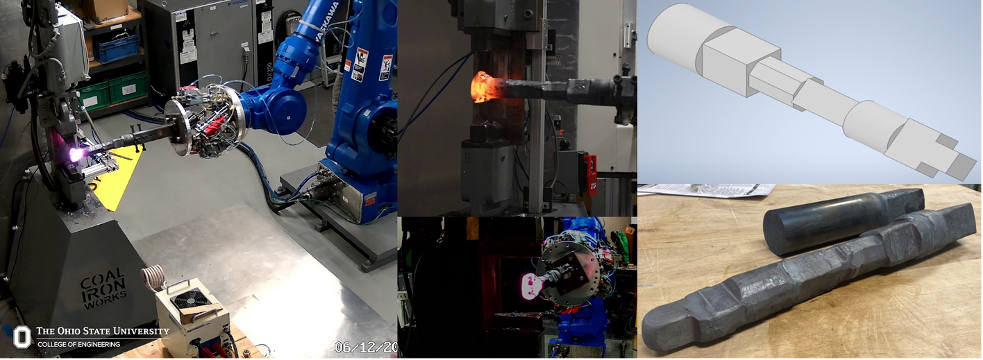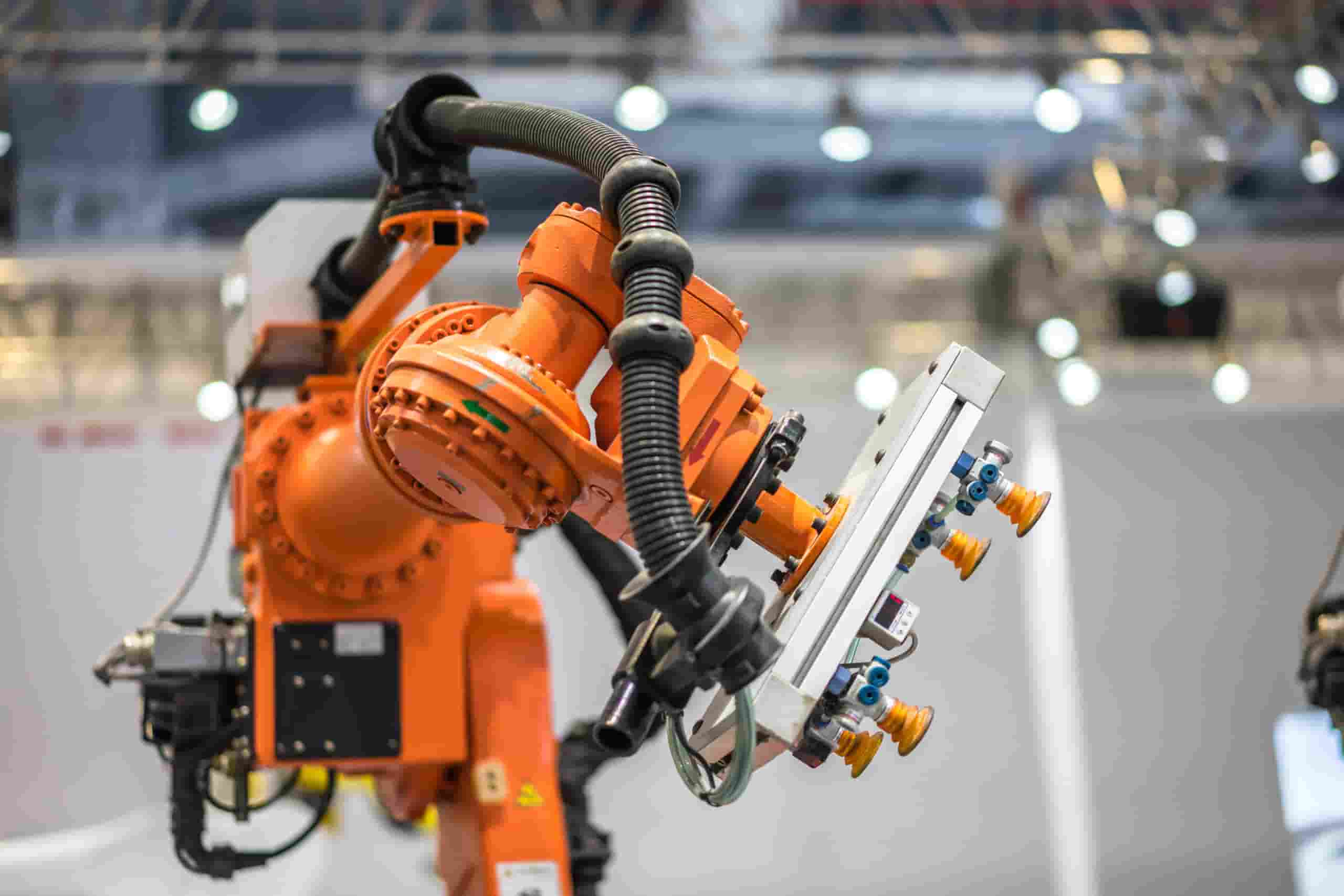
The ARM Institute and our 450+ member organizations collaborate to solve key issues facing both the Department of Defense and the wider manufacturing industry, generating dual-use solutions. One keen area of focus for the institute has been robotic solutions for casting and forging. The casting and forging industries are critical to both the Department of Defense and wider industries. From manufacturing ship propeller shafts, ammunition nose cones, and engine turbine blades for the Department of Defense to components needed for the wider aerospace, agriculture, railroad, and automotive industries, casting and forging processes power more than you may think.
The use of robotics and automation in casting and forging represents a major opportunity to make this work safer, augment workforce gaps, make outputs/components more consistent, and enable firms to have the resources needed to meet demand. Addressing these challenges is key to strengthening overall U.S. manufacturing, as well as reviving our Defense Industrial Base, thus rebuilding our military.
This robotic iterative forging project team collaborated on two projects to address robotic solutions for forging. In this highlight, learn how the team leveraged the phase one project to demonstrate the viability of their robotic solution for iterative forging and used phase two of the project to address stakeholder feedback and strengthen the robotic iterative forging system for adoption.
Project Team:
The Ohio State University (Principal Investigator), CapSen Robotics, and Yaskawa Robotics
Background:
The failure of a critical component can ground a military aircraft or shut down a factory. Replacement parts are often 1) difficult to obtain due to supply chain issues, 2) not cost-effective to keep on hand, and 3) not easily produced in-house considering manufacturing workforce shortages. Lost production while waiting for replacements can cost millions of dollars per day and grounded weapon systems can hinder the mission of the Department of Defense, putting our national security and deterrence at risk.
To tackle this issue plaguing both the Defense Industrial Base and wider manufacturing industry, the Ohio State University partnered with CapSen Robotics and Yaskawa on two ARM Institute projects focused on autonomous robotic metal forging, which addressed the challenge of low volume, high mix production of complex metallic components. The first project developed an autonomous robotic artisan capable of performing thermomechanical processing of metal components – specifically iterative open-die forging with heat treatment. The system iteratively cycles components between integrated equipment that heats material, takes geometric measurements, and performs shaping operations using varied tooling.
The robotic iterative forging phase two project was successfully demonstrated at Warner Robbins Air Logistics Center. During the demonstration, the project team received valuable feedback on how to further improve the system. The second project, titled Autonomous Robotic Iterative Forging Phase 2, was a follow-on project that addressed this feedback, centering on accelerating the productivity of the robotic iterative forging system through a series of system design modifications. Feedback received from the key stakeholders was keenly focused on improving the system speed and focusing on certain materials and geometries of interest.
Technical Approach:
The general process of iterative open-die forging, thermal treatment, and machining has been long validated as a viable manufacturing workflow by artisan metalworkers. However, the control of this workflow by an integrated robotic system was a novel demonstration of the first project executed by this team. The initial implementation required integrating six main areas:
- simulation of material response
- forging process planning
- component gripping and positioning
- robotic execution of forging
- component geometry reconstruction
- material state updating and model correction.
In the follow-on project, the team leveraged this implementation and focused on modifications to improve the efficiency of their initial robotic iterative forging system.
Impact:
The first Autonomous Robotic Iterative Forging project successfully demonstrated forging of an aluminum alloy for aerospace-relevant components at an Air Logistics Center (ALC) in Warner Robbins, GA. While this process can produce critical components of interest to the Department of Defense, the technology is also dual use. Metallic components of similar nature are commonplace in the commercial automotive sector, high-end auto sports, heavy-duty factory machinery, powerplants, and other land and sea-based military equipment.
In the second project, the project team accelerated the productivity of the system, centering on the following areas to improve the speed, all of which were met:
- Reduce the time required to position the component on the lower die
- Remove (the need for) pauses during pressing to relieve forces and torques
- Allow for larger amounts of deformation to be taken on each iteration
- Reduce the number of images needed for component geometry reconstruction
- Reduce time to heat material to forging temperatures
- Reduce amount of deformation needed to transform the initial geometry to the final geometry
- Reduce frequency of component imaging (ie increase deformation between imaging)

Outputs Available to ARM Members:
ARM Members, as well as the Department of Defense, have exclusive access to the consortium-developed intellectual property (CDIP) generated through the robotic iterative forging phase two project and all ARM Institute-funded projects.
Specific outputs available to ARM Members from this project include:
- Software developed that includes press control software, Dream3D build used for decision making, and Python script used to coordinate the sequence of actions. All CapSen PiC deployment (configuration) files have been made available in the Github repository. This includes all parameter files, URDFs, action scripts, and device files.
- Software documentation and instructions for implementation are supplied as README markdown files as part of the Github repository.
- The project’s final report with details of technical progress and test results.
- Powerpoint presentations and recordings from the project kick-off and final demonstration.
ARM Members can access these outputs and others in the ARM Member Community. Email [email protected] for assistance using the Community.
More About ARM Institute Projects
ARM Institute projects catalyze collaboration across the Institute’s 450+ member organization consortium. These projects leverage experts across industry, government, and academia to produce impactful robotics and artificial intelligence (AI) solutions in manufacturing. Projects are selected from ARM Institute Project Calls, which detail areas of need as determined by ARM Institute experts, members, and government stakeholders.
Want to get involved in projects? Explore ARM Institute membership here.
Join our mailing list
ABOUT THE ARM INSTITUTE
The Advanced Robotics for Manufacturing (ARM) Institute is a Manufacturing Innovation Institute (MII) funded by the Office of the Secretary of Defense under Agreement Number W911NF-17-3-0004 and is part of the Manufacturing USA® network. The ARM Institute leverages a unique, robust, and diverse consortium of 450+ members and partners across industry, academia, and government to make robotics, autonomy, and artificial intelligence more accessible to U.S. manufacturers large and small, train and empower the manufacturing workforce, strengthen our economy and global competitiveness, and elevate national security and resilience. Based in Pittsburgh, PA since 2017, the ARM Institute is leading the way to a future where people & robots work together to respond to our nation’s greatest challenges and to produce the world’s most desired products. For more information, visit www.arminstitute.org and follow the ARM Institute on LinkedIn and X (formerly Twitter).
